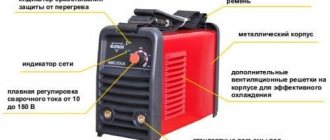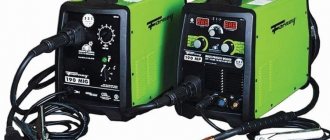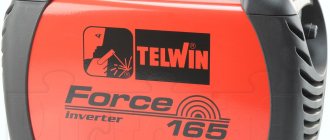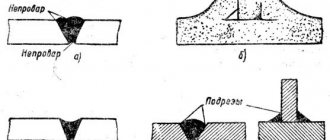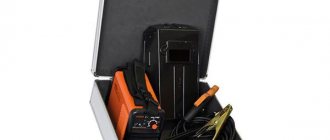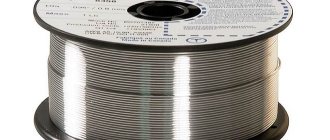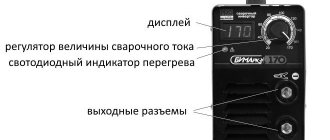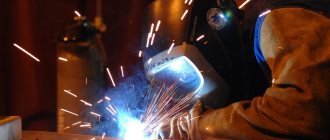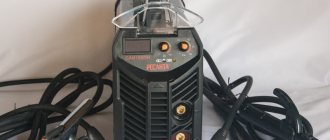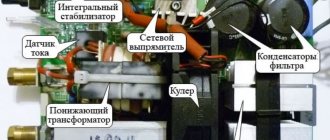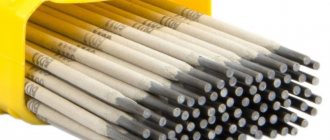USEFUL FUNCTIONS OF INVERTER WELDING MACHINES
ARC FORCE - When the arc voltage due to a large drop formed on the electrode falls below a certain minimum value, the current automatically increases. This helps the drop to break away from the electrode rod, thereby allowing the electric arc to be freed and not extinguished. Thanks to the ARC FORCE function, the transfer of droplets through the arc gap becomes clear and uniform.
HOT START (Hot start) - is responsible for reliable ignition of the arc and sufficient heating on the still cold base material at the beginning of welding. To do this, at the moment the electrode touches the product, a short-term increase in the value of the welding current occurs.
ANTI STICK (Anti-sticking) - prevents calcination of the electrode when ignition of the arc fails and the electrode “sticks” to the product. Heating of the electrode caused by resistance can damage the coating of the electrode until it peels off. To prevent this from happening, if after an ignition short circuit there is no increase in voltage, the current is immediately reduced to several amperes. After this, the electrode can be easily separated from the workpiece, and the inverter resumes the set welding parameters.
VRD (Voltage Reduction Device) - translated from English means “Voltage Reduction Device”. The essence of the operation of this device is to reduce the no-load voltage of the source to 9-12 volts that are safe for humans, i.e. The voltage decreases when the machine is turned on, but welding is not performed. As soon as the welding process begins, the VRD device restores the operating voltage parameters.
Source: axion-svarka.ru
Practice welding deception. How not to make a mistake when choosing a device. Part 1
When coming to a store or looking at online portals, the buyer first of all looks at the price tag of the equipment presented, naturally looking for an option that would be optimal in terms of cost and quality ratio.
At the same time, price is not always an objective selection criterion. It is in the lowest price category that there is a huge layer of low-quality goods. In this article we will talk about technologies that are used to deceive buyers.
Let's start with the simplest:
Overestimation of current characteristics
Often the numbers indicated on devices, in instructions or on equipment boxes have nothing to do with reality. It happens that the promised and actual values of the welding current differ by 20 or even 50%. For example, instead of the declared 200A, the device produces only 125.
When choosing a welding machine, the buyer looks at the upper limit of the welding current and compares the price with competitors based on their technical characteristics. As you understand, the cost of 120 and 200A devices differs significantly in favor of the first, and you are offered to pay for it as for a much more powerful device.
A professional never buys a welding machine with the current characteristics that he needs, i.e. If a welding specialist needs a 180A current source, then in the store he will opt for a 200 - 250A inverter. This choice, on the one hand, protects the buyer from underestimating the characteristics, on the other hand, allows you to have a reserve of power.
The manufacturer, knowing about this feature of the choice, periodically overestimates the current characteristics. As a result, the power reserve that the buyer expects to receive turns out to be zero, but the allegedly “200A” device costs a little more than the 180A analogue.
Another trick of marketers is to assign a name to a device with a digital code, which hints at the welding current, but has nothing to do with it. Let's take, for example, the imaginary device “Oak 250” (I hope there is no such thing), or even “Oak 250A” - the name seems to hint to us that the device should have a current of 250 A, while in the instructions for the inverter it is indicated 160A, but who reads these pieces of paper? So, less attention to the inscriptions on the case - more time studying the devices.
When making leapfrogs with characteristics, sellers rely on the buyer’s superficial knowledge. The average welding enthusiast will not be able to check the characteristics of the tool he plans to purchase.
Unfortunately, our people trust advertising or “digital displays” more, which often have nothing to do with real current. Here is clear proof: in one of our videos dedicated to comparing welding machines, we tested the ELAND inverter:
Welding current type: direct (DC) or alternating (AC)
Cooking with constant (or direct, in English - DC) current is simpler: it is easier to hold the arc. Therefore, 99.9% of modern MMA inverter machines produce constant welding current.
But among transformers, previously the majority were AC devices.
Alternating current (in English - AC) is used for welding non-ferrous metals. But not with MMA devices, but with TIG devices. Therefore, an MMA welding inverter that produces alternating current is a rarity.
Additional functions of welding inverters
welding inverter pro arc 200
When manufacturers of welding inverters talk about their advantages, mentioning the additional functions of ARC force, HOT start, etc., this, of course, is more advertising than talk about real advantages. By and large, talking about such additional functions of welding machines is the same as talking, for example, about switches, that they not only turn off, but also turn on the electrical power! The point is that the functions presented as additional ones are actually an integral part of inverter technology. However, all these features of inverter technology simplify the welding process, making it accessible and simple not only for professionals, but also for neophytes. Here are the main ones: HOT start - simple ignition of the arc. Difficulties with igniting the arc often arise among beginners. At the moment of ignition, the welding current increases to the required value, then the operating parameters are restored. ANTI stick – prevents the problem of electrode sticking during arc ignition. The welding current is reduced without the participation of the welder, automatically. Arc force – provides ease of welding and simplifies welding of vertical seams. In Russian, arc force. VRD – lowering U idle speed until it reaches a normal (safe) level.
Maximum electrode diameter
Essentially the same characteristic of the operating current range. Sometimes, due to illiteracy or malicious intent, the diameter of the electrode is indicated, which will not be able to cook with the stated maximum current. Sometimes it’s the other way around: the maximum diameter of the electrode is indicated, which clearly does not reach the value of the declared welding current.
The latter option is occasionally a glimpse into the conscience of deceptive suppliers. They indicate the short-circuit current as the maximum current. But the maximum working diameter of the electrode is still indicated honestly.
Duty cycle, also known as PV (on period), also known as PN (payload)
PV is indicated by two numbers. The first is current strength. The second is the percentage of time. For example, “130A-50%” means that this device with a current of 130A can cook half the time. And the same amount of time will remain idle, waiting for cooling to operating temperature. If measurements are carried out at the maximum current of the device, the first digit is omitted, leaving only the percentage indicator. For example, if a device with a rating of 160A has the entry “30%” opposite “PV”, this means that with a current of 160 amperes it can operate 30% of the time, and 70% will cool down.
That's right. It only remains to add that the domestic GOST R IEC 60974-1-2004 does not establish a single mandatory method for measuring the PN indicator for MMA devices. “The standard does not apply to limited duty manual arc welding power supplies that are designed primarily for use by non-professionals.”
The European methodology, set out in the EN60974-1 standard, suggests measuring on a load stand at an ambient temperature of 40C only until the first shutdown due to overheating. The result obtained is referred to a 10-minute period. It turns out that the thermal protection worked after 3 minutes, the cycle of the device at this current is 30%.
Methodology of the TELWIN concern. To date, it is used by most Chinese manufacturers (those that generally conduct such tests on their cars). The Italian concern itself, when measuring the PV of its devices using its own method, modestly indicates “TELWIN” after the indicator. The vast majority of Chinese manufacturers do not do this.
MMA welding method
Before considering the method itself, you should learn about MMA electrodes, that these are special melting metal rods coated with special compounds for connecting different grades of steel.
The main stages of this type of welding, such as MMA, what it is, the nuances and features are described by the technology for performing the work, which is as follows.
The current supplied to the electrode forms an arc with a high temperature between the surface of the products to be welded and the metal of the rod. When the rod and the surface of the product are heated, a melting area is formed. In the volume of metal brought to a liquid state, a special zone is created - a weld pool, into which the melting metal of the electrode enters in the form of individual particles covered with slag.
In the melting zone, the incoming metal and product material are mixed, and the lighter molten slag is pushed onto the surface of the formed weld. The maximum recess at which the metal of the welded element is melted is called the “penetration depth”.
The dimensions of the weld pool depend on the work mode. In manual MMA arc welding, the share of the metal of the product in its formation reaches 35%.
When the electrode coating melts in the weld pool, a special gas regime is formed. Gases released during MMA welding displace air and form a protective environment that prevents direct contact of the melt with the external environment. This layer contains mainly vapors of molten steel or other metals and alloying substances.
Selection and features of the power supply network. Functional features of inverters.
If you connect the inverter to a stationary 220 V network, pay attention to the actual voltage in the network. If it is often low, choose an inverter model whose manual specifically indicates the supply voltage range and the ability to operate at low voltage. Most models remain operational with voltage deviations within 220 V ±15%, i.e. can withstand a voltage drop in the network up to 187 V, and with a larger drop they can turn off or suddenly lose power.
A number of inverter models operate stably at a voltage drop of 25% (up to 165 volts in the network), for example:
Inverter devices Forsazh-200, Forsazh-200M - operate stably when the voltage drops to 140 V, losing little power.
Forsazh -200 Forsazh-200M
■ Connection to a generator: If you plan to connect to an electric generator, it is important to know that the voltage at the generator output can fluctuate significantly, especially depending on the load. The inverter must be protected from voltage surges and the documentation must indicate the possibility of connecting to a generator (power plant).
Models recommended for operation from a 220V generator: IZH VD-200, Forsazh -200, Neon VD -201, NEON VD-221, for a generator with a voltage of 3x380V: - Forsazh-301, Neon VD-315, Forsazh-502. In the technical specifications of the inverter, pay attention to the recommended generator power, which is indicated for the maximum welding current. Read more about choosing an inverter for connecting to a generator in the article: “Welding inverters for poor networks.”
Additional functions and options of modern inverters: no-load voltage reduction devices, Digital indication of welding current (ammeter, display, etc.).
■ Digital indication (ammeter, display, etc.): Digital indication of welding current allows you to set and visually control the value of the welding current with high accuracy, for example in models Neon VD-201, NEON VD-221, ARC-205B (Z203) Svarog , BARS Profi ARC-257D, Forsazh-301, which allows you to quickly adjust the required current with frequent changes in the welding mode (when welding different thicknesses with electrodes of different diameters). The actual value of the welding current differs from the preset value (preset) and is adjusted during welding. The digital display also greatly helps novice welders set up the welding mode.
■ Devices for reducing no-load voltage: When carrying out welding work in conditions of high humidity, confined spaces and cramped conditions (wells, tunnels, tanks, etc.), to comply with safety requirements, welding inverters with a built-in device (unit) for reducing no-load voltage ( VRD), which ensures the electrical safety of the welder. It should be borne in mind that the no-load voltage of the device (50-80V) is dangerous, so this device reduces the no-load voltage of the welding inverter to a safe value of 9-15V when the welding circuit is opened and returns the inverter to its original state when the electrode touches the part. Inverters with such a device, for example ARC-205B "Svarog", NEON VD-221, NEON VD-315, Forsazh-301, ARC-500 VRD "Svarog" are used for welding in the energy sector, in the construction of oil and gas pipelines, and in the chemical industry.
Expert answers
Enter your name
Enter your Email
Navigation through information sections
Unfortunately the brand
This product has been discontinued. You can ask your question in the form below. Our specialists can provide complete information about the product and conduct an expert comparison of analogues!
We are confident that we have the lowest prices for brand products
! But, you can challenge this statement if you find a lower price in another store. In return, we will make an even better offer! Read the terms and conditions.
We guarantee that your inquiries by mail or in the form of a call back
we will respond within 15 minutes
. And to demonstrate the seriousness of their intentions, they are ready to pay
500 rubles to your mobile phone
, if we do not meet this time.
There are often different equipment/material options that vary in price, reliability, ease of use, and options. We have an exclusive offer -
Let's make an expert comparison
and select a product that
will satisfy your needs
Some brands have a policy that prohibits them from posting prices of their products online. But, you can always find out the latest information about the price and availability of goods from our managers.
We are always ready to provide the best offer on the market! You have a large order or require a large number of units of this product - we can discuss special conditions and provide wholesale prices!
NAKS certification is one of the requirements of Rostechnadzor. Carrying out activities at facilities that are under the authority of Rostechnadzor without NAKS certification is problematic and often impossible. This statement is regulated by the FNP Rostechnadzor “Requirements for welding work at hazardous production facilities” (approved by Order of Rostechnadzor dated March 14, 2014 No. 102, registered by the Ministry of Justice of Russia on May 16, 2014).
When ordering, please indicate which group of technical devices you need a NAKS certificate for.
Also, our managers can assist you in obtaining a NAKS certificate for equipment you already have or equipment that you purchased without a certificate.
BestWeldGlobus 180
The inverter showed itself in tests as a tool intended for real welding professionals. Representatives of the Best model range have proven themselves when working under low pressure conditions. Moreover, among them you can choose those samples that have a price significantly lower than the model described.
Read also: How to ring wiring in a wall
Testing showed the excellent capabilities of the 180th Globe. For convenient carrying there is a suitcase, approximately the same as the one used by the creators of the Telwin company. The inverter has a folding handle and a strap for easy transportation; completeness is also ensured by a good-quality mass clamp, thick, pleasant-to-touch wires, and a large collapsible mask, which experts advise replacing with an analogue of smaller sizes.
The Globus 180 inverter has two fans and a radiator located between them, which works like a cooler. All elements of the vertical board are on one side. The installation is dense and neat, as well as convenient large parts.
Using a high-quality digital indicator, you can quickly and conveniently set the required welding current parameters. During testing, it produced, instead of the declared parameters within the range of 5-180, a range of 9-178, but such an error is insignificant. The 180th model of the Globe shows itself perfectly on the stand. The device is distinguished by reliable operation until the moment the protective system is triggered; at this moment the voltage readings were about 160 V.
Arc ignition and arc retention are better than all other models tested. An electrode with a diameter of 4 millimeters ignites at 40 A!
Experts, assessing all these advantages of the inverter, unanimously place it among the most unpretentious and confidently operating. And the low parameters of the minimum welding current provide every reason to use this tool for body repair and other types of welding that require a certain finesse.
No load voltage
After turning on the device, until the arc is ignited, the voltage at the tip of the electrode is significantly higher than during operation. And the higher it is, the easier it is to ignite the arc. But standards prohibit open-circuit voltage levels on devices delivering direct current above 100V.
To further reduce risks, the so-called VRD blocks. A device equipped with a VRD has only a few volts at the tip of the electrode before the arc starts. And only when you touch the metal, the no-load voltage is restored to the level necessary to ignite the arc.
All electrodes always indicate the polarity of the connection, the type of welding current (direct or alternating) and the minimum level of open circuit voltage required for ignition. For the vast majority of widely used electrodes, it does not exceed 60V.
The open circuit voltage, as well as the welding current, depends on the input voltage level. The lower the voltage in the power supply, the lower the open circuit voltage. Therefore, as the supply voltage decreases, ignition of the electrode becomes more and more difficult.
